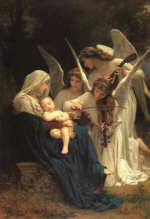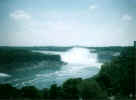|
HOME
CONTEMPLATIONS
REFLECTIONS
REVERBERATIONS
WORKS
REVELATIONS
REMEMBRANCES
DERIVATIONS
ELUCIDATIONS
EXPANSIONS
ECHOES
GLOSSARY
SEARCH
FAQ
LINKS
|
|

 The
encumbrance of language in the spoken word which arises from the sheer
volume of words essential to imparting a given conceptual meaning,
progression of intended meaning or message in the skills of verbal
communication, becomes cogently obvious to one who composes in the
non-verbal language of music. The same barrier to such fluid and
ultimate meaning in perceptual purport as exists in verbal expression is
found in classical music. Although therein the beautiful flowing
dynamics may also misbeseem such a barrier, that sonorous sleight of
hand is the magic of why many music lovers appreciate classical music so
profoundly. It draws one into absorption. Thus it becomes critical to
the music devotee to go beyond that communicative barrier inherent also
in the language that is music. This barrier may express as an
interpretive block of emotion, for example, or of conceptual awareness
as another example. For once comprehension past any such block occurs,
something is simply understood more deeply. There might be a certain
passage in a symphony which brings about the resolution of emotion
one holds for a person, a memory, a concept or a thing, even, and which
resolution may help to vitally determine the course of one's day, or
eventually destiny in life. This is precisely why it is said that
classical music enlightens its devotees. There must be figure skaters
and ballerinas who became engrossed in their discipline only to pursue
their deep fascination with such other-worldly music, and to express in
physical form their love for classical. How many times we hear of a love
song or an entire style of dance music which had helped bind together a
couple in marriage for a lifetime; and how many citizens gain
perspective and vision at community gatherings at all levels when
hearing the National Anthem, and other patriotic songs? The power and
moment for instrumental music of all styles to affect the listener much
as any spoken language even minus the music is perhaps more subtle, more
difficult to comprehend directly, and yet this end result is what the
composer of a classical piece works to achieve in any composition: in
effect a story is
told. The
encumbrance of language in the spoken word which arises from the sheer
volume of words essential to imparting a given conceptual meaning,
progression of intended meaning or message in the skills of verbal
communication, becomes cogently obvious to one who composes in the
non-verbal language of music. The same barrier to such fluid and
ultimate meaning in perceptual purport as exists in verbal expression is
found in classical music. Although therein the beautiful flowing
dynamics may also misbeseem such a barrier, that sonorous sleight of
hand is the magic of why many music lovers appreciate classical music so
profoundly. It draws one into absorption. Thus it becomes critical to
the music devotee to go beyond that communicative barrier inherent also
in the language that is music. This barrier may express as an
interpretive block of emotion, for example, or of conceptual awareness
as another example. For once comprehension past any such block occurs,
something is simply understood more deeply. There might be a certain
passage in a symphony which brings about the resolution of emotion
one holds for a person, a memory, a concept or a thing, even, and which
resolution may help to vitally determine the course of one's day, or
eventually destiny in life. This is precisely why it is said that
classical music enlightens its devotees. There must be figure skaters
and ballerinas who became engrossed in their discipline only to pursue
their deep fascination with such other-worldly music, and to express in
physical form their love for classical. How many times we hear of a love
song or an entire style of dance music which had helped bind together a
couple in marriage for a lifetime; and how many citizens gain
perspective and vision at community gatherings at all levels when
hearing the National Anthem, and other patriotic songs? The power and
moment for instrumental music of all styles to affect the listener much
as any spoken language even minus the music is perhaps more subtle, more
difficult to comprehend directly, and yet this end result is what the
composer of a classical piece works to achieve in any composition: in
effect a story is
told.

Now for the purpose of exploring how the structure of classical music
works in eliciting conceptual awareness, perceptive ability and acuity,
as well as emotional reaction, and further, emotionally reactive
resolution, the jazz style of composition might prove dialectically
useful to an analysis. An analysis of jazz composition constitutes a
useful tool in the understanding of the utility of structural elements
in the classical music art form, since jazz can be considered to be in
its most improvisational dimension, as much as raw numbers. These raw
numbers are not assorted in an easily discernable sequence. For such an
easily discernable sequence would have allowed predictability based upon
strict harmonics, for instance. And further, those harmonics which do
sound, may occur then again in dramatically asymmetrical chord changes.
Therefore, they are as much the raw material of a highly subjective
interpretation for the listener, and as well for the performer.
Essentially, each note and/or chord in such a jazz music style, since it
has its own place in yet sheer sequence, and in perhaps even varying,
syncopated or "straying" rhythm in that sequence, carries a
lesser degree of expectedness; therefore, the very infrastructure of the
improvisational/free jazz piece largely constitutes its greater
structure, its overall direction and sound. This means that the utmost
dimension in jazz music, as is achieved in such an ultimate form of
jazz, relies upon an expansion of notes, whose place in regard to one
another is quite arbitrary, or loosely contained. Such an expansion
relates to the listener a broad venue for interpretation, and thus the
expansive style of the styles of jazz, the improvisational reaching into
the free style, lends the greatest leverage perceptively for a deeper
subjective realization when it is heard; in the vernacular, it is, 'way
out there.' This composer was greatly enlightened unto all of music by
understanding improvisational and free jazz, and most especially by
listening to the music compositions of Miles Davis.

People in general enjoy the subjective mode in which to revel. In such a
subjective reverie or even query they tend to realize a deep inner calm
and assuredness, or perhaps a new revelation to some degree on any topic
which might be posed for reflection in the art of everyday living. For
it is the subjective aspect of cognition upon which an individual relies
in order to process the moments in living, the way to be chosen for such
living, and what to expect at each turn, as the next moment or juncture
is met. A highly integrative process occurs when the realm of music is
visited. While enjoying the sound of a free jazz composition, the
subjective query is at once met and resolved to some extent, lending a
deep satisfaction. The expansive mode builds accordingly to an overall
and even more expansive style, and once this ever-expanding realm of
music is heard and understood, the mind rests upon a new venue, a new
truth. The new insights thus gained might have the power to also affect
the rational, discriminating faculty of the one so completely moved, and
whose direct awareness of this integration of discerning mind and
emotion might not even be there. Yet that awareness of such a deep inner
process in the self is exactly what drives the composer and the musician
to create, and more especially is this so for the composer. For it is
the composer who drives the musical artists in their expression and in
their desire to find what the composer had intended to say. Any musical
form of course owes its aesthetic roots to the selfsame theoretical
truth, whereby the objective reality is related back again to the
ability to synthesize that objective venue according to its essential
truth through the use of the subjective discriminating faculty. A
musical form whose message calls forth a subjective platform more
elevated than that of non-discriminatory sense desires will tend to
nurture a deeper self-realization in an individual. 
 Now if the greater challenge in
classical music composition is indeed that barrier of communication
within the language of music; and, if as compared to the expansive
attributes of free/improvisational jazz, the macrostructure of classical
is constrained unto its symmetry in harmonics, melody and timing; then a
serious question is indeed posed as to the attributes of classical music
to match those of jazz insofar as its expansion capabilities. Now if the greater challenge in
classical music composition is indeed that barrier of communication
within the language of music; and, if as compared to the expansive
attributes of free/improvisational jazz, the macrostructure of classical
is constrained unto its symmetry in harmonics, melody and timing; then a
serious question is indeed posed as to the attributes of classical music
to match those of jazz insofar as its expansion capabilities.
If, however,
there can be discerned at least an equal ability of classical music to
inspire an expansion of mind in the subjective faculty of the listener,
then a convincing case has been made indeed for the sheer beauty of
classical music, let alone its power to enlighten those who admire
it. For one who revels in the daring riff of endless, seemingly
infinite dimension of improvisational jazz, there would be no further
question or discussion on the theoretical query before us: for how can a
strictly-governed music form such as classical music ever find that
place to soar almost untethered? Jazz is unbound to such constant
requirement of ordered sequence and harmonics, not to mention the joy in
the feature of random chord changes. Is this kind of refutational
style of music, free jazz, unique in its unabounding reach only because
it finds its place by that very refutation of precise
structure?
The evidence in
favor of the capability of classical music to achieve an ever-growing
venue of subjectively-based ardor for the contemplative and higher
realms of endless traverse is overwhelming, indeed. This composer
has a profound love for jazz, so that there is in this query a great
desire to be as objective as possible; for the tenets of truth on the
expansions of music as can be drawn from this comparative analysis in no
way constitute preferential bias towards one musical art form or
another. Rather, in this comparative analysis there might be drawn
a greater insight as to truth, and that truth should apply equally to
both music forms, free jazz and classical.

What might be
evidence for the expansive realm that is the dominion of the ancient
classical music art? The answer lies in the place of structure,
macrostructure, to also equally embrace the musical sense and
discriminatory faculties of the classical music devotee and composer.
The answer also is found in the power of the pleasing nature of the
horizontal and vertical dynamics, or the melodious and harmonically
perfected phrases of classical works. For this precision of structure in
the classical style further primes the musical sensitivities of the
listener as the piece progresses, causing there to be a more
removed leverage to transcend into the realm of ever-increasing
awareness, as the macrostructure of the piece, however exacting, becomes
heard. This less direct transcendence into the ethereal realm
through the vehicle of classical is perhaps seemingly a less spontaneous
venture into the ulterior mode of launch into the infinite capabilities
of the mathematical venue by sound, the mathematical venue that is all
music. However, that spontaneity which embraces the heart of the
listener of classical is filled and replete with the very nature of
music as to its essential physical comprise. The grosser-level
construct of classical music reflects then again in perfection's hold
the more subtle truth of the construction of the sound wave itself.
Since sound waves are cyclic in nature, then it can be assumed that to
create a music which is less linear than free jazz, and more contained,
yet also expansive within its message, mimics the repetitive moment of
the sound waves which becomes heard.
Moreover, the
most valued standard from which to measure the sound of music being made
by instruments, is that of the human voice. Any musical
instrument which approaches the most pleasing, natural sound of the
vocal instrument, is valued by the knowers of music, whether studied in
music or  not. The art of singing is traditionally also constrained
unto definite rules of composition and is ordered by harmony and melody,
much as in the cadences of talking. The similarity between solely
instrumental classical music and singing as to the predictable
element of progression and the spontaneity found within that sure
structure, in contrast to the random nature of improvisational
jazz, even with its freer spontaneity, attracts the ear to the
classical music sound in a most deep-seated way. Thus further, the
classical music which is expressed through choirs of voices
together, is so momentous, that the great religious composers excel at
creating sonorous tributes to the glory and highness of God.
not. The art of singing is traditionally also constrained
unto definite rules of composition and is ordered by harmony and melody,
much as in the cadences of talking. The similarity between solely
instrumental classical music and singing as to the predictable
element of progression and the spontaneity found within that sure
structure, in contrast to the random nature of improvisational
jazz, even with its freer spontaneity, attracts the ear to the
classical music sound in a most deep-seated way. Thus further, the
classical music which is expressed through choirs of voices
together, is so momentous, that the great religious composers excel at
creating sonorous tributes to the glory and highness of God.
The final point
which must be addressed concerns the power of virtually raw numbers for
equations in music, and which raw numbers are found as was herein said
earlier in free jazz, to have a greater impetus in the subjective self
for realizing a message in music as a language. Is it that the
generous expanse of the almost random sequence of jazz allows a deeper
realization of self as compared to the precise and more symmetrical,
definitionally-structured classical style? This question contends
for its ultimate resolution in the mind of the beholder, the listener,
of course. However, that sheer mathematical journey with an upper
limit and very few rules of order in its ascent, the jazz piece,
constitutes a less succinct statement than does its
dialectically
 opposed counterpart, the classical piece. This basic point causes
the dialectically-based analysis of classical and jazz to rest
once again on the value of perfection and wholesome ideation for an
ultimate consideration in the solution of the argument. Contrary
to some tastes in music, the vague and formless ideation of the jazz
musical art form would challenge a person whose subjective predilection
is for visible truth, wherein a more exacting message is also consoling
for its likelihood of being widely interpreted in the same way--this is
seen as a validation of its universal import. The one whose
subjective demeanor in the interpretation of the resonating annals of
sound as according to like mind, wherein a more formless kind of music
says the most, will gravitate to the improvisational jazz
statement. Therefore, it becomes debatable in an endless fashion
to characterize one musical art form, jazz or classical, as more or less
expansive in its respective moment to inspire self-realization.
However, in analyzing the respective differences between classical music
and jazz, more understanding of both musical art forms can be
had. Most importantly, one who has never embarked upon the
classical music venture in learning experience at all, or perhaps very
little, and who is familiar with jazz, can gain a better idea of what is
classical music through this dialectically-posed analysis. Anyone
who cares to know more of this ancient music, classical, is most special
to this composer, who had also arrived at classical music as an active
composer through the route of intense jazz realization.
opposed counterpart, the classical piece. This basic point causes
the dialectically-based analysis of classical and jazz to rest
once again on the value of perfection and wholesome ideation for an
ultimate consideration in the solution of the argument. Contrary
to some tastes in music, the vague and formless ideation of the jazz
musical art form would challenge a person whose subjective predilection
is for visible truth, wherein a more exacting message is also consoling
for its likelihood of being widely interpreted in the same way--this is
seen as a validation of its universal import. The one whose
subjective demeanor in the interpretation of the resonating annals of
sound as according to like mind, wherein a more formless kind of music
says the most, will gravitate to the improvisational jazz
statement. Therefore, it becomes debatable in an endless fashion
to characterize one musical art form, jazz or classical, as more or less
expansive in its respective moment to inspire self-realization.
However, in analyzing the respective differences between classical music
and jazz, more understanding of both musical art forms can be
had. Most importantly, one who has never embarked upon the
classical music venture in learning experience at all, or perhaps very
little, and who is familiar with jazz, can gain a better idea of what is
classical music through this dialectically-posed analysis. Anyone
who cares to know more of this ancient music, classical, is most special
to this composer, who had also arrived at classical music as an active
composer through the route of intense jazz realization.
Yours ever,
Marilynn Stark
January 1, 2003
© 2002-2003
by Marilynn Stark All Rights Reserved.

HOME
CONTEMPLATIONS
REFLECTIONS
REVERBERATIONS
WORKS
REVELATIONS
REMEMBRANCES
DERIVATIONS
ELUCIDATIONS
EXPANSIONS
ECHOES
GLOSSARY
SEARCH
FAQ LINKS

mail
to: marilynn@starkmusic.com
 
 
©2000-2007 By Marilynn Stark All Rights
Reserved
|
